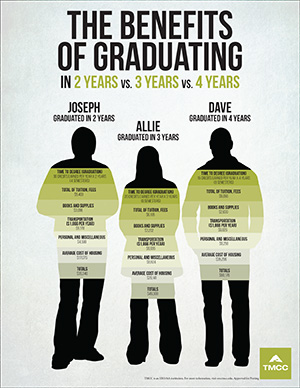
Cost comparison of graduating in two years, three years or four years. Source: TMCC Financial Aid. Click on image to enlarge. Infographic by Brandie Davis.
Tuition at a community college can be half as expensive as undergraduate tuition at a four-year university, and there are additional methods to reduce expenses even further.
The cost of attendance is a budget that Truckee Meadows Community College posts on its website to help students determine total costs of a college degree.
“Aside from tuition and fees, the other factors are an average calculated using city data,” said Jeannette Smith, Financial Aid Coordinator for Scholarships and Outreach at TMCC. “While tuition and fees are beyond their control, students can make different choices to positively impact other factors that contribute to their cost of attendance.”
One example is reducing housing costs.
“A Nevada resident, taking 12 credits will pay $3,030 in tuition and fees,” she said. “However, they don't necessarily have to spend $9,065 on room and board if they live with a roommate or have a more affordable living option.”
There are steps college students can explore to reduce costs in several categories:
- Course planning
- Financial aid savvy and scholarship exploration
- Books and supplies available for check-out or online
- Transportation sharing or discount bus passes
- Housing research or down-payment assistance
Course Planning is Step 1 in Reducing Costs
Planning out each semester beforehand has the potential to reduce the cost of a two-year degree by thousands of dollars.
Smith estimated the total of all average living expenses when completing an associate degree in four academic years—between 2014–2015 and 2016–2017—would run more than $60,000.
When she entered in the average costs of all living and college expenses to complete the degree across three years, it came out to $49,300. So, shaving one year off the completion date would save more than $11,000.
Expenses incurred completing an associate degree in two years would total $36,340. This is a savings of more than $23,000 from that same degree completed in four years. (Complete infographic appears top right.)
Students can most effectively lower the time to complete their degree by setting clear goals.
“The Career Center will help you figure out what career and degree you’d most like to explore,” Smith said. “They have interest or aptitude inventories you can take and the staff can help figure out which degrees would lead down your desired career path.”
Also Career Exploration workshops are scheduled every two weeks during Fall and Spring Semesters. For more information about these workshops, call 775-673-7060.
The next part of this step is best sequencing the courses in a student’s degree program.
“Working with an academic advisor and talking about efficient course planning will get you to your degree without inadvertently taking any courses not specifically required for that program,” she said. “And take a look at your budget to know if taking a full load is possible."
The Academic Advisement, Transfer Center and International Student Advising Services are in Red Mountain Building, room 111, 775-673-7062.
Smith added that if a full load of classes each semester is not feasible, taking classes during the summer and winter terms can lighten the course load during regular semesters.
Step 2: Financial Aid and Scholarship Exploration
“Make sure that financial aid is in order and that you’ve explored all options,” she said. “TMCC staff can help students find unique scholarships that many people don’t know are available. There is also guidance for filling out forms and getting the award that you’re interested in.”
The Governor Guinn Millennium Scholarship and Silver State Opportunity Grant are offered by the state of Nevada. Students may apply for federal, state and TMCC grants.
Financial Literacy and Money Education by Students (FLAMES) are student mentors who offer one-to-one peer mentoring for financial literacy and host workshops about federal financial aid. FAFSA is the Free Application for Federal Student Aid, a document that the federal government uses to determine eligibility for many types of financial help such as grants and scholarships.
There are two additional types of scholarships at TMCC: internal and external.
- Internal scholarships through TMCC Foundation
- External scholarships from organizations and credit unions
Steps 3 and 4: Reducing Costs of Books and Supplies, and Transportation
Many students may not be aware that textbooks for core classes are available for use in the Elizabeth Sturm Library at the reference desk. The texts can be read and studied in the library.
Open educational resources and other open-source materials are also online and free to use. The Library’s staff has an in-depth knowledge of where numerous free resources can be found on the Web.
To reduce the cost of transportation, Smith advises students to check out carpooling options.
“Many students are already sharing rides and combining trips,” she said. “The Student Government Association, or SGA, also offers help with discount bus passes.”
Bus passes are economical at $115 for six months and can be purchased at the Cashier’s Office. Also, for those who drive, parking at TMCC is free.
Step 5: Housing Costs
Help with reduced-cost housing options can be found on the TMCC Re-Entry Center’s student resources page.
In the housing and shelter section of the student resources page, listed are community agencies such as the Catholic Charities of Northern Nevada and Northern Nevada Veterans Resource Center.
“There are community groups that help with down-payment assistance,” Smith added. “Students can also lower rental costs by finding a friend that they know well and trust to be a roommate.”
TMCC's Retention and Support Services and the Student Resources Team are launching a food and personal supplies pantry in late August. This will help with emergency needs experienced by under-resourced students.
For more information about average college costs, contact Financial Aid, Scholarships and Student Employment.






